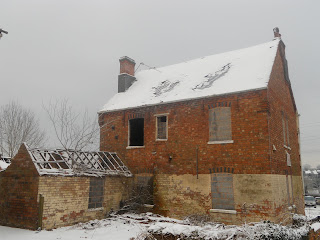I was told about a plot of land in bedworth where there are two abandoned buildings, which are perfect for my current project. Naturally I went there straightaway to have a look. What I found was literally amazing. The houses were on quite a large bit of land next to a main road- and were in total disrepair. There was ivy and other plant life growing all over them (in some cases through the roof) and they looked as though they could fall apart at any second: total desolation. It was PERFECT.
I wanted to continue my focus on abandoned buildings/ areas, and this was the best starting point. Here are some photos of the discovery:
I then went back to the house in the snow for some more photos, I thought snow on top of the already ruined house would be very interesting.
The houses have been a brilliant source of inspiration, and I am currently working on pieces based on what I have found there.

















